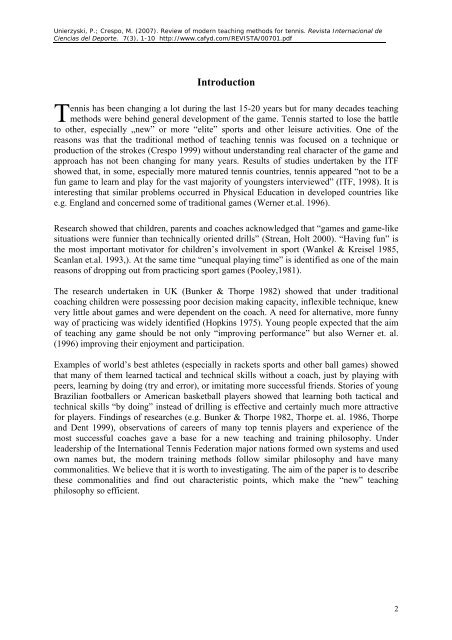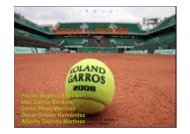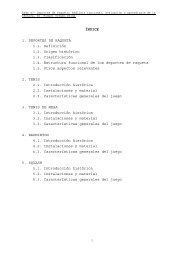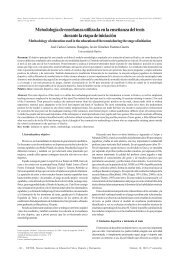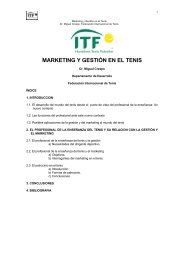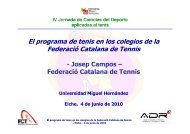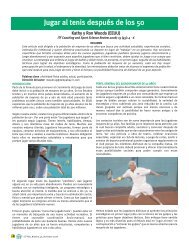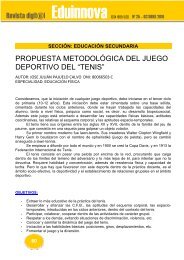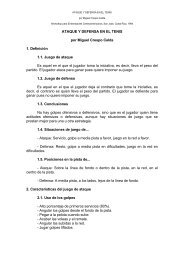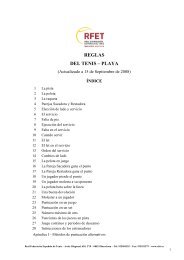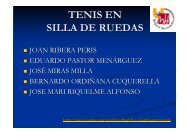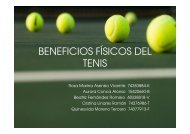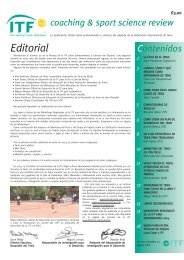Review of modern teaching methods for tennis ... - Miguel Crespo
Review of modern teaching methods for tennis ... - Miguel Crespo
Review of modern teaching methods for tennis ... - Miguel Crespo
Create successful ePaper yourself
Turn your PDF publications into a flip-book with our unique Google optimized e-Paper software.
Unierzyski, P.; <strong>Crespo</strong>, M. (2007). <strong>Review</strong> <strong>of</strong> <strong>modern</strong> <strong>teaching</strong> <strong>methods</strong> <strong>for</strong> <strong>tennis</strong>. Revista Internacional deCiencias del Deporte. 7(3), 1-10 http://www.cafyd.com/REVISTA/00701.pdfTIntroductionennis has been changing a lot during the last 15-20 years but <strong>for</strong> many decades <strong>teaching</strong><strong>methods</strong> were behind general development <strong>of</strong> the game. Tennis started to lose the battleto other, especially „new” or more “elite” sports and other leisure activities. One <strong>of</strong> thereasons was that the traditional method <strong>of</strong> <strong>teaching</strong> <strong>tennis</strong> was focused on a technique orproduction <strong>of</strong> the strokes (<strong>Crespo</strong> 1999) without understanding real character <strong>of</strong> the game andapproach has not been changing <strong>for</strong> many years. Results <strong>of</strong> studies undertaken by the ITFshowed that, in some, especially more matured <strong>tennis</strong> countries, <strong>tennis</strong> appeared “not to be afun game to learn and play <strong>for</strong> the vast majority <strong>of</strong> youngsters interviewed” (ITF, 1998). It isinteresting that similar problems occurred in Physical Education in developed countries likee.g. England and concerned some <strong>of</strong> traditional games (Werner et.al. 1996).Research showed that children, parents and coaches acknowledged that “games and game-likesituations were funnier than technically oriented drills” (Strean, Holt 2000). “Having fun” isthe most important motivator <strong>for</strong> children’s involvement in sport (Wankel & Kreisel 1985,Scanlan et.al. 1993,). At the same time “unequal playing time” is identified as one <strong>of</strong> the mainreasons <strong>of</strong> dropping out from practicing sport games (Pooley,1981).The research undertaken in UK (Bunker & Thorpe 1982) showed that under traditionalcoaching children were possessing poor decision making capacity, inflexible technique, knewvery little about games and were dependent on the coach. A need <strong>for</strong> alternative, more funnyway <strong>of</strong> practicing was widely identified (Hopkins 1975). Young people expected that the aim<strong>of</strong> <strong>teaching</strong> any game should be not only “improving per<strong>for</strong>mance” but also Werner et. al.(1996) improving their enjoyment and participation.Examples <strong>of</strong> world’s best athletes (especially in rackets sports and other ball games) showedthat many <strong>of</strong> them learned tactical and technical skills without a coach, just by playing withpeers, learning by doing (try and error), or imitating more successful friends. Stories <strong>of</strong> youngBrazilian footballers or American basketball players showed that learning both tactical andtechnical skills “by doing” instead <strong>of</strong> drilling is effective and certainly much more attractive<strong>for</strong> players. Findings <strong>of</strong> researches (e.g. Bunker & Thorpe 1982, Thorpe et. al. 1986, Thorpeand Dent 1999), observations <strong>of</strong> careers <strong>of</strong> many top <strong>tennis</strong> players and experience <strong>of</strong> themost successful coaches gave a base <strong>for</strong> a new <strong>teaching</strong> and training philosophy. Underleadership <strong>of</strong> the International Tennis Federation major nations <strong>for</strong>med own systems and usedown names but, the <strong>modern</strong> training <strong>methods</strong> follow similar philosophy and have manycommonalities. We believe that it is worth to investigating. The aim <strong>of</strong> the paper is to describethese commonalities and find out characteristic points, which make the “new” <strong>teaching</strong>philosophy so efficient.2


